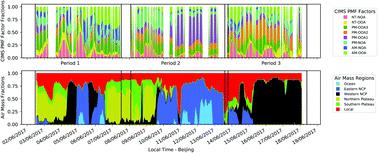当前位置:
X-MOL 学术
›
Faraday Discuss.
›
论文详情
Our official English website, www.x-mol.net, welcomes your feedback! (Note: you will need to create a separate account there.)
Using highly time-resolved online mass spectrometry to examine biogenic and anthropogenic contributions to organic aerosol in Beijing
Faraday Discussions ( IF 3.4 ) Pub Date : 2021-1-21 , DOI: 10.1039/d0fd00080a Archit Mehra 1 , Manjula Canagaratna , Thomas J Bannan , Stephen D Worrall , Asan Bacak , Michael Priestley , Dantong Liu , Jian Zhao , Weiqi Xu , Yele Sun , Jacqueline F Hamilton , Freya A Squires , James Lee , Daniel J Bryant , James R Hopkins , Atallah Elzein , Sri Hapsari Budisulistiorini , Xi Cheng , Qi Chen , Yuwei Wang , Lin Wang , Harald Stark , Jordan E Krechmer , James Brean , Eloise Slater , Lisa Whalley , Dwayne Heard , Bin Ouyang , W Joe F Acton , C Nicholas Hewitt , Xinming Wang , Pingqing Fu , John Jayne , Douglas Worsnop , James Allan , Carl Percival , Hugh Coe
Faraday Discussions ( IF 3.4 ) Pub Date : 2021-1-21 , DOI: 10.1039/d0fd00080a Archit Mehra 1 , Manjula Canagaratna , Thomas J Bannan , Stephen D Worrall , Asan Bacak , Michael Priestley , Dantong Liu , Jian Zhao , Weiqi Xu , Yele Sun , Jacqueline F Hamilton , Freya A Squires , James Lee , Daniel J Bryant , James R Hopkins , Atallah Elzein , Sri Hapsari Budisulistiorini , Xi Cheng , Qi Chen , Yuwei Wang , Lin Wang , Harald Stark , Jordan E Krechmer , James Brean , Eloise Slater , Lisa Whalley , Dwayne Heard , Bin Ouyang , W Joe F Acton , C Nicholas Hewitt , Xinming Wang , Pingqing Fu , John Jayne , Douglas Worsnop , James Allan , Carl Percival , Hugh Coe
Affiliation

|
Organic aerosols, a major constituent of fine particulate mass in megacities, can be directly emitted or formed from secondary processing of biogenic and anthropogenic volatile organic compound emissions. The complexity of volatile organic compound emission sources, speciation and oxidation pathways leads to uncertainties in the key sources and chemistry leading to formation of organic aerosol in urban areas. Historically, online measurements of organic aerosol composition have been unable to resolve specific markers of volatile organic compound oxidation, while offline analysis of markers focus on a small proportion of organic aerosol and lack the time resolution to carry out detailed statistical analysis required to study the dynamic changes in aerosol sources and chemistry. Here we use data collected as part of the joint UK–China Air Pollution and Human Health (APHH-Beijing) collaboration during a field campaign in urban Beijing in the summer of 2017 alongside laboratory measurements of secondary organic aerosol from oxidation of key aromatic precursors (1,3,5-trimethyl benzene, 1,2,4-trimethyl benzene, propyl benzene, isopropyl benzene and 1-methyl naphthalene) to study the anthropogenic and biogenic contributions to organic aerosol. For the first time in Beijing, this study applies positive matrix factorisation to online measurements of organic aerosol composition from a time-of-flight iodide chemical ionisation mass spectrometer fitted with a filter inlet for gases and aerosols (FIGAERO-ToF-I-CIMS). This approach identifies the real-time variations in sources and oxidation processes influencing aerosol composition at a near-molecular level. We identify eight factors with distinct temporal variability, highlighting episodic differences in OA composition attributed to regional influences and in situ formation. These have average carbon numbers ranging from C5–C9 and can be associated with oxidation of anthropogenic aromatic hydrocarbons alongside biogenic emissions of isoprene, α-pinene and sesquiterpenes.
更新日期:2021-01-21



























 京公网安备 11010802027423号
京公网安备 11010802027423号